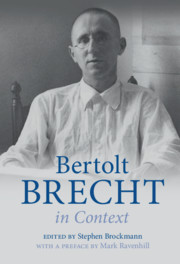Book contents
- Bertolt Brecht in Context
- Bertolt Brecht in Context
- Copyright page
- Contents
- Figure
- Notes on Contributors
- Chronology
- Abbreviations
- Preface
- A Note on Brecht in English
- Introduction
- Part I Brecht’s World
- Part II Brecht’s Work
- Part III The World’s Brecht
- Chapter 23 Brecht and Feminism
- Chapter 24 Brecht in Southern Africa
- Chapter 25 Brecht in the Creation, Production, and Analysis of Opera Today
- Chapter 26 Brecht and His Biographers
- Chapter 27 Brecht Editions
- Chapter 28 Brecht and German Studies
- Chapter 29 Beginning Where Brecht Left Off: Heiner Müller and Brecht’s Legacy
- Chapter 30 Bertolt Brecht in Brazil
- Chapter 31 World Spirit versus Spirit of the Age: Brecht’s Impact and Influence on East German Literature and Culture
- Chapter 32 Brecht in Fiction
- Chapter 33 Brecht and Contemporary Experimental Theater
- Chapter 34 Brecht and US Actor Training
- Chapter 35 Brecht and Transcultural Theater
- Chapter 36 Thinking Brecht in(to) the University
- Chapter 37 “Shrunk in Translation” or: The (Ir)resistible Rise of the Old Traduttore/Traditore Tradition …
- Concise Bibliography
- Index
Chapter 27 - Brecht Editions
from Part III - The World’s Brecht
Published online by Cambridge University Press: 28 May 2021
- Bertolt Brecht in Context
- Bertolt Brecht in Context
- Copyright page
- Contents
- Figure
- Notes on Contributors
- Chronology
- Abbreviations
- Preface
- A Note on Brecht in English
- Introduction
- Part I Brecht’s World
- Part II Brecht’s Work
- Part III The World’s Brecht
- Chapter 23 Brecht and Feminism
- Chapter 24 Brecht in Southern Africa
- Chapter 25 Brecht in the Creation, Production, and Analysis of Opera Today
- Chapter 26 Brecht and His Biographers
- Chapter 27 Brecht Editions
- Chapter 28 Brecht and German Studies
- Chapter 29 Beginning Where Brecht Left Off: Heiner Müller and Brecht’s Legacy
- Chapter 30 Bertolt Brecht in Brazil
- Chapter 31 World Spirit versus Spirit of the Age: Brecht’s Impact and Influence on East German Literature and Culture
- Chapter 32 Brecht in Fiction
- Chapter 33 Brecht and Contemporary Experimental Theater
- Chapter 34 Brecht and US Actor Training
- Chapter 35 Brecht and Transcultural Theater
- Chapter 36 Thinking Brecht in(to) the University
- Chapter 37 “Shrunk in Translation” or: The (Ir)resistible Rise of the Old Traduttore/Traditore Tradition …
- Concise Bibliography
- Index
Summary
This article examines the development of German-language Brecht editions, beginning with the first series of Brecht works, Versuche (1930–1933), which emphasized the experimental nature of Brecht’s work.This was followed by the the Gesammelte Werke (Collected Works, 1938) with the Malik Publishing Company, which served as a protective shield against Nazi efforts to wipe Brecht out.After World War II Brecht initiated a new publication, organized by genres, with Suhrkamp in 1953 and Aufbau in 1955.This edition was edited by Brecht’s collaborator Elisabeth Hauptmann and grew to encompass forty volumes.The 1967 Suhrkamp edition became particularly significant for spreading Brecht’s work among West German student radicals of the 1960s and 1970s.Finally, the most current and only real critical edition is the Berlin-Frankfurt edition (BFA, 1988–2000), which for the first time gives readers insight into the entirety of Brecht’s work.The edition of Brecht’s Notizbücher (notebooks), begun in 2010, is ongoing.The article explores how these editions got their start, how they were conceived, what they achieved, and what limitations they had. The most important question is the extent to which any static print edition of Brecht’s work can illuminate the living, changing processes of Brecht’s interests, methods, and approaches.
Keywords
- Type
- Chapter
- Information
- Bertolt Brecht in Context , pp. 233 - 241Publisher: Cambridge University PressPrint publication year: 2021

